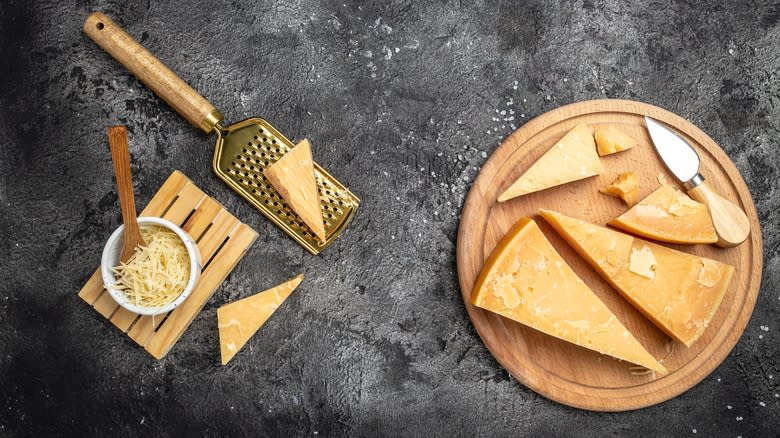The Basic Qualities America Looks For When Labeling Parmesan

Parmesan cheese is one of those versatile ingredients that can find its way into many of your culinary projects. Yet, labels can indicate different kinds of products depending on your location. While parmesan is highly regulated in Italy, American definitions are much less strict.
For it to be labeled as parmesan in the U.S., the FDA has mandated that it must be aged for a minimum of 10 months and hold no more than 32% moisture and no less than 32% milk fat. The texture of the cheese must also be brittle and granular yet can be held by a hard rind that can be grated over a plate of food.
Though many Americans associate parmesan as a harder cheese to grate over spaghetti, the texture of cheese made in Italy is often closer to cheddar and peppered with crunchier bits of calcium lactate. Parmigiano Reggiano is a dairy product that by law can only come out of specific areas and Italians recognize it not only as a topping for pasta dishes like bucatini cacio e pepe but as pieces meant to be savored alone or dipped into balsamic vinegar.
Read more: 13 Unexpected Ingredients To Elevate Lasagna
Parmesan Is More Strictly Regulated In Italy

Parmigiano Reggiano's origins began with monks in the Middle Ages who milked free-range cows in Italy. To this day, what these European cows can eat is strictly regulated, unlike those responsible for the production of the American version. Law also dictates that Italy's parmesan contains unaltered milk, salt, and the enzyme rennet. Once the cheese has been aged for at least one year, inspectors evaluate wheels by hand and reject products should they fail either texture or taste.
When figuring out which parmesan cheese to buy to complement your next meal, keep in mind that the flavor can vary due in part to the amount of time it has been aged. When this dairy product is made stateside it can also be produced with any type of milk, artificial colors, cellulose, and calcium chloride can be added. So, if you're looking to buy authentic Parmigiano Reggiano, the package should indicate that the cheese was made in or comes from Italy, and you'll see a PDO label somewhere in print.
Read the original article on Tasting Table

